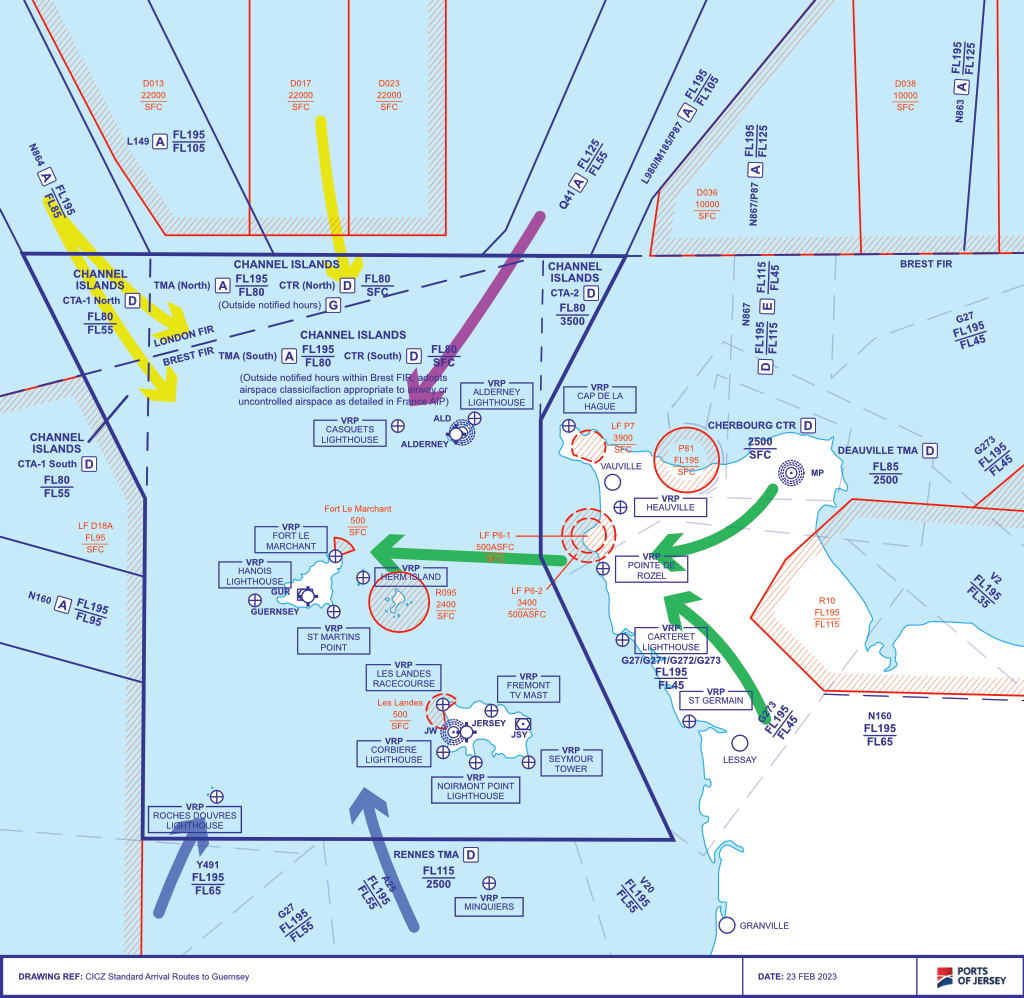In order to reduce the risk of delay, re-routing or extensive holding, flights inbound for Guernsey requiring a VFR or “Special” VFR clearance should plan entry along notified recommended routes.
These have been established in order to keep VFR traffic clear of any restricted areas, deconflicted from IFR Departures and Arrival tracks and to deconflict with other VFR/SVFR traffic transiting to/from the other islands.
Inbound flights to Brecqhou and Jethou should book CI CTR PPR in the same manner as those for Guernsey.
GUERNSEY ARRIVAL ROUTES

Inbound VFR or Special VFR flights to Guernsey will normally be granted clearance to enter via one of the following Visual Reference Points, Prominent Geographical Features or Towns:
- ORTAC (ORTAC) [IFR Reporting Point at 50N at the NE corner of the Channel Island CTR)
- Pointe de Rozel (ROZEL)
- Roches Douvres Lighthouse (ROCHE)
- 49N from Dinard (DIN)
- 50°N (50N) from Berry Head (BHD) or Portland Bill (PB)
To simplify the flight planning process the abbreviations indicated in brackets () above may be used in the route field of a VFR flight plan.
These entry routes are associated with defined Arrival Sectors which will be subject to a PPR Reservation based on an estimate for the zone boundary.
Recommended Cross Channel Routes
A recommended VFR Route has been established for traffic crossing the English Channel between St. Catherine’s Point and the Cherbourg Peninsular (Cherbourg NDB (MP)).
From the MP entry can be planned via Pointe de Rozel (ROZEL) and the Fort Le Marchant (FORT) Guernsey.
In order to plan a more direct route west of Danger Area D036 it is possible to fly direct from The Needles Lighthouse on the Isle of Wight to ORTAC (ORTAC).
Please take care to remain clear of or below the airway Q41 (Base FL55) north of ORTAC.
UK NPPL holders who do not hold a certificate of ICAO compliance to fly in French Airspace MUST contact the Jersey ATC Supervisor in order to secure an arrival clearance/route which will enable the flight to remain in UK or Channel Islands Airspace. Please contact Jersey ATC Supervisor on the PPR Enquiry Line +44 1534 446309.
NOISE ABATEMENT – ARRIVAL AND CIRCUIT PROCEDURES
The following Noise Abatement Procedures apply to all aircraft arriving at Guernsey. Please Note: This is a summary of the local noise abatement procedures and Pilots should review the textual elements of the Guernsey Section of the UK AIP for comprehensive procedures including those required for departure.
These procedures may at any time be departed from to the extent necessary for avoiding immediate danger.
Every operator using the airport shall ensure that at all times aircraft are operated in a manner calculated to cause the least disturbance practicable over all parts of the island.
Unless ATC otherwise authorise, the Noise Preferential Routings and Procedures specified below shall apply to all aircraft approaching and landing at Guernsey in accordance with the ATC clearance and shall apply in both VMC and IMC.
Visual Approaches – Aircraft intending to carry out visual approaches should proceed as follows:
(i) MTOW 5700 kg or less – join the final approach at not less than, and maintain, 836ft amsl (500 ft aal) until intercepting the on glidepath PAPI indications.
(ii) MTOW greater than 5700 kg – join the final approach before crossing the coastline. Any aircraft overflying the Island to position on final approach must do so at an altitude of not less than 1500 ft amsl.
Circuit Joining and Training Height – Standard circuit height is 700 ft aal.
All aircraft are to avoid overflying the Princess Elizabeth Hospital (2 nm ENE of the aerodrome) at less than 1000 ft agl.
